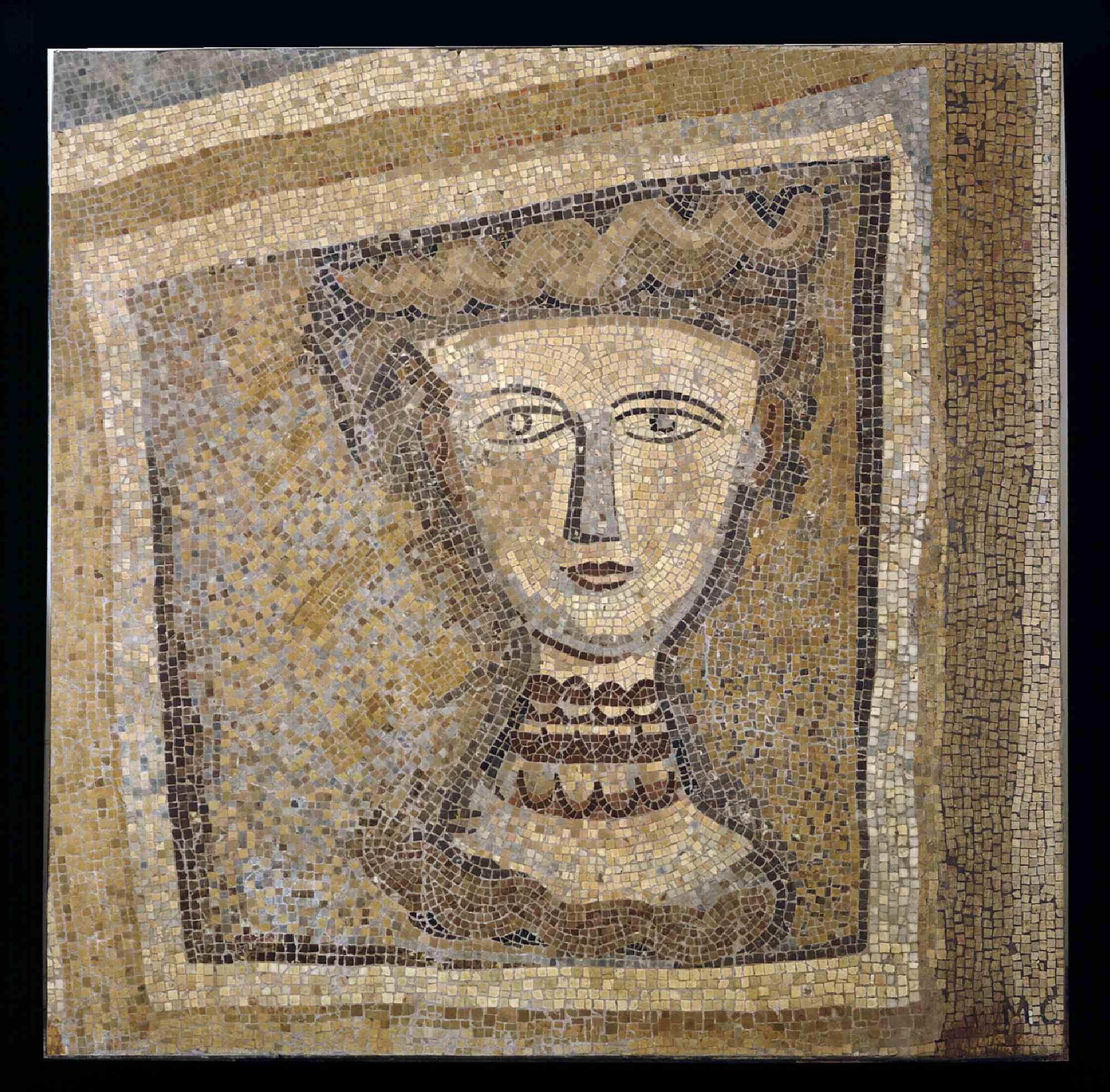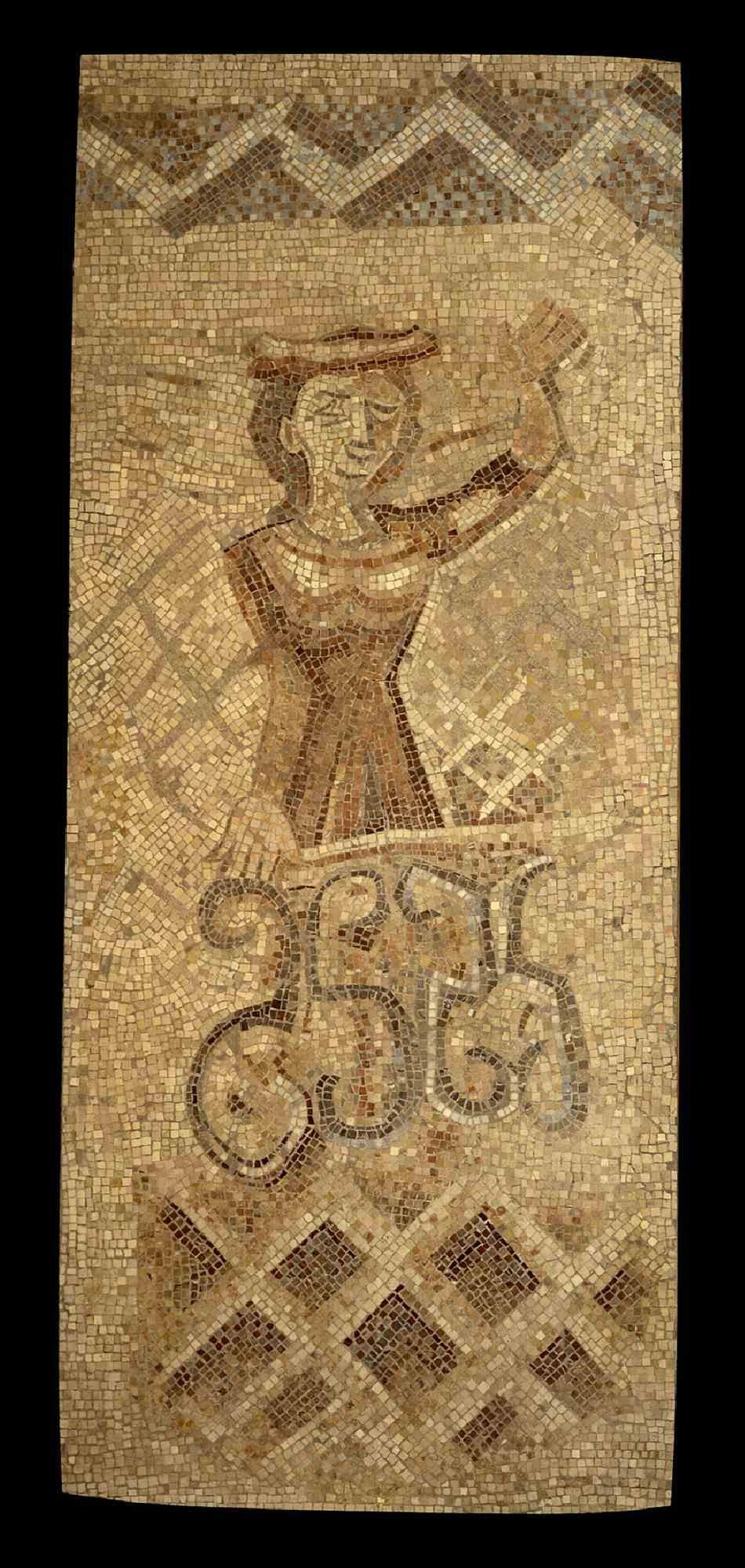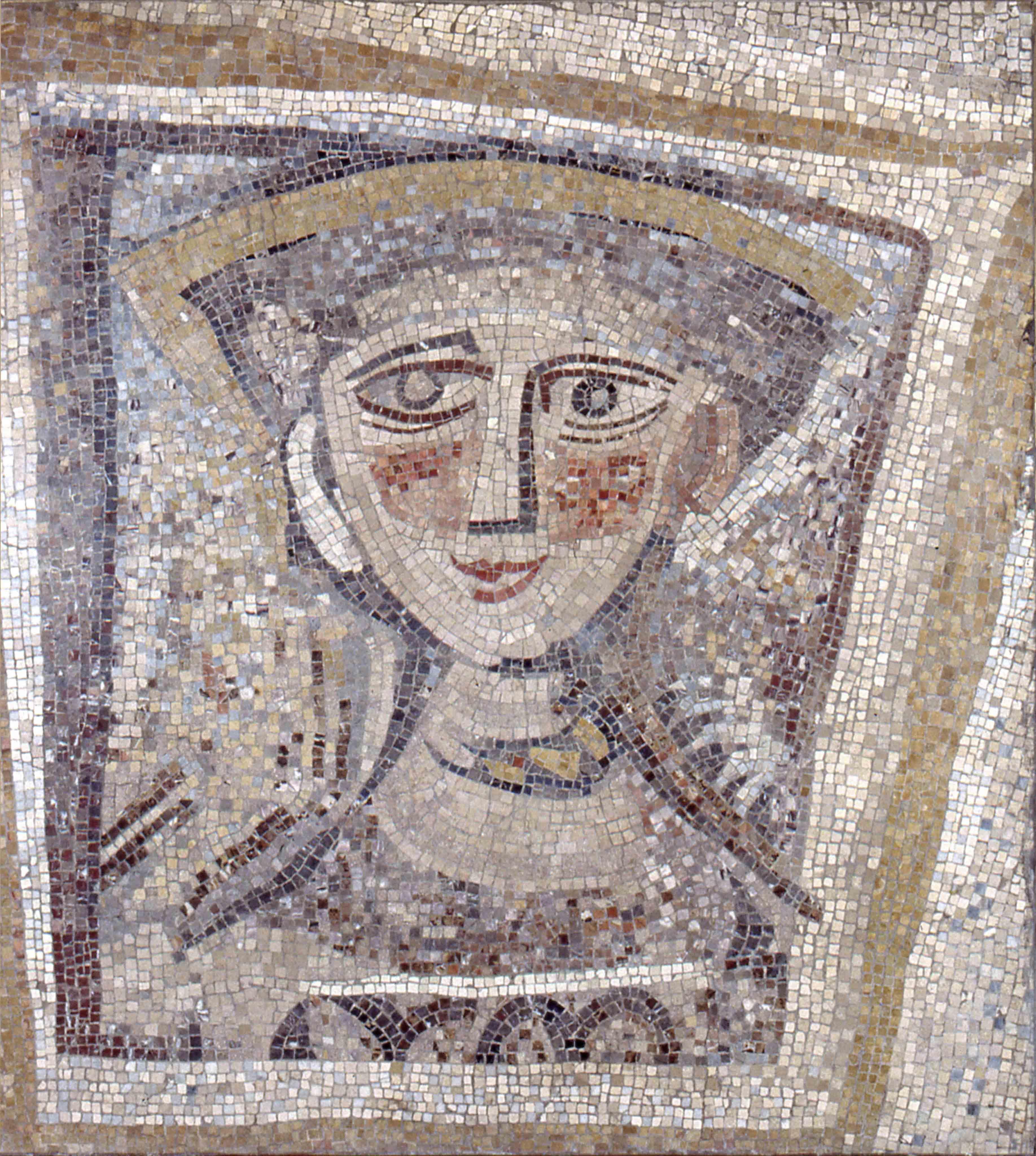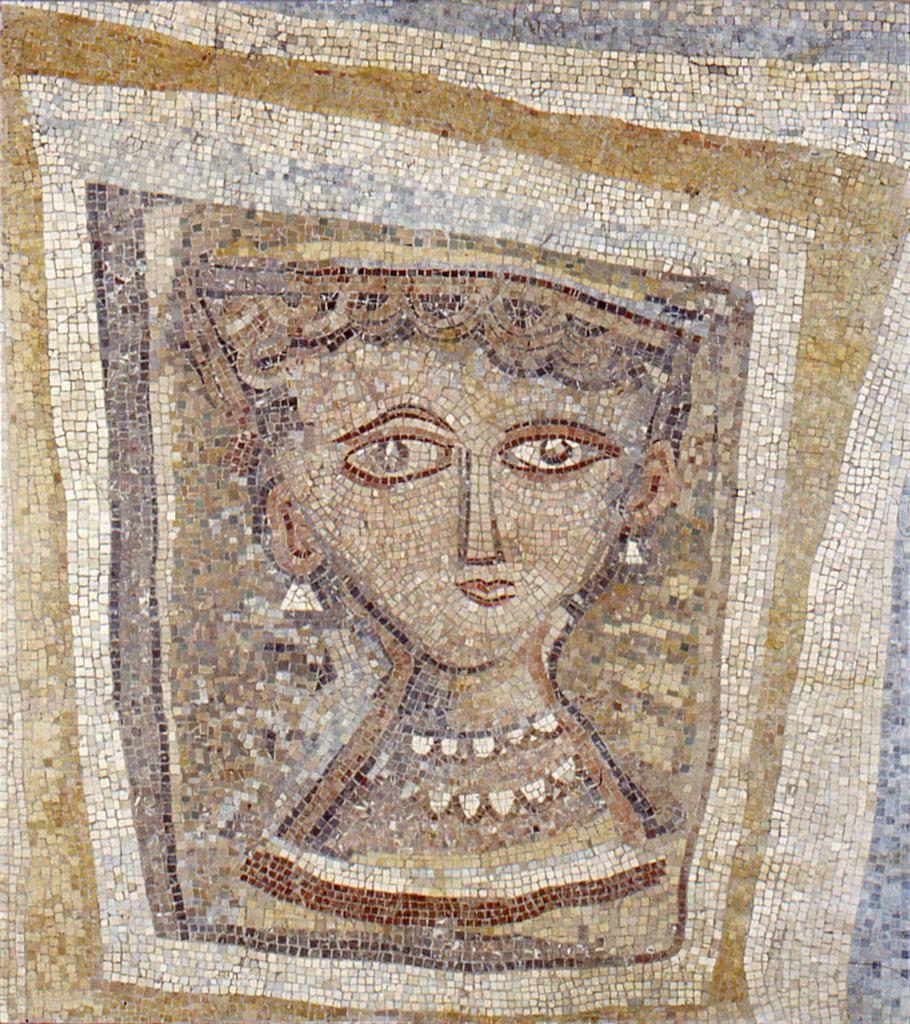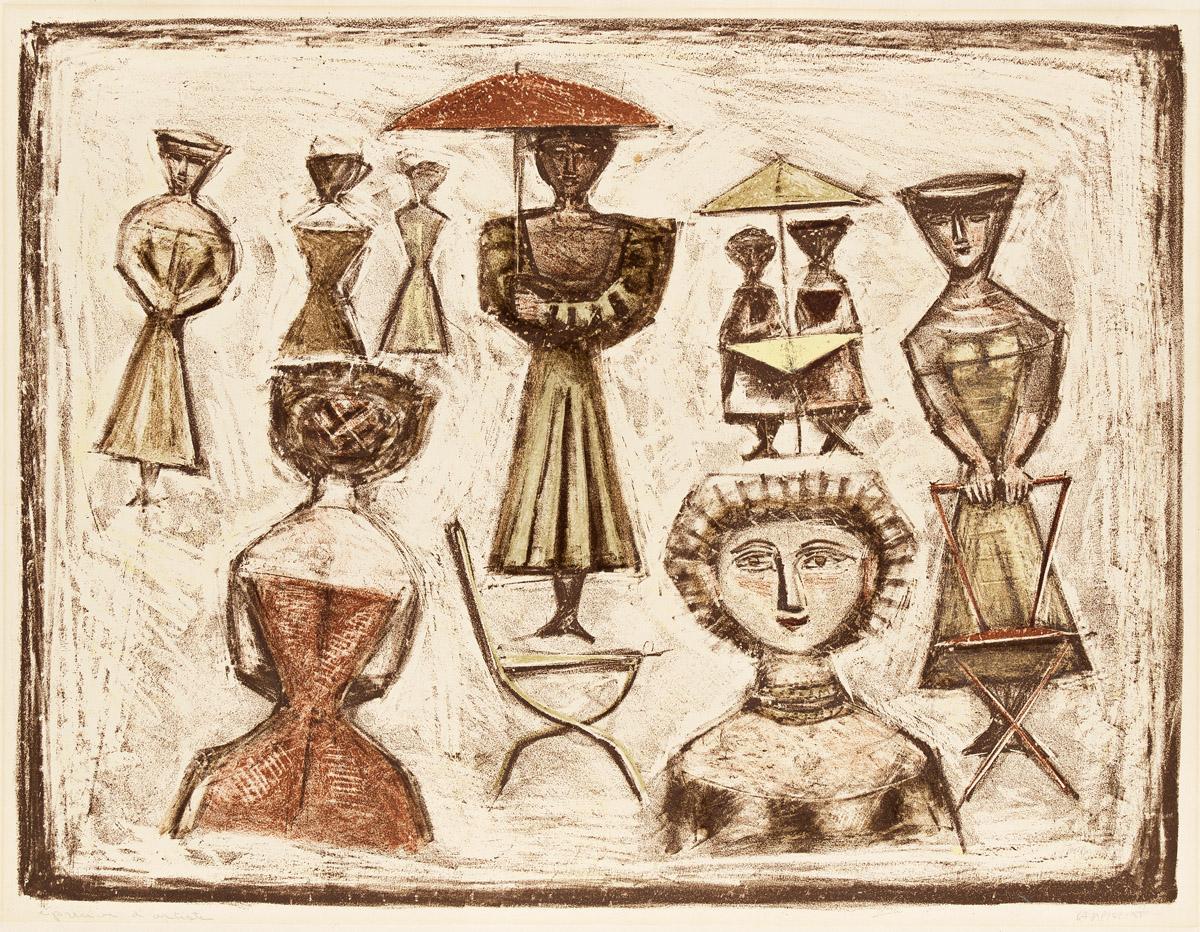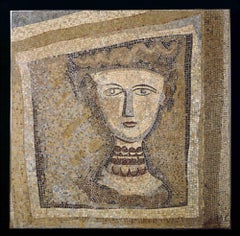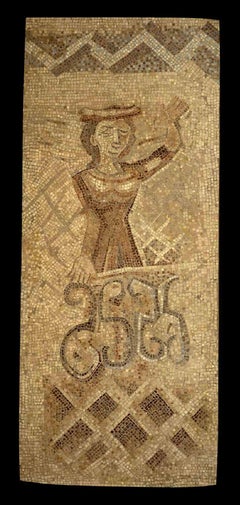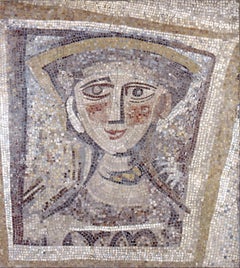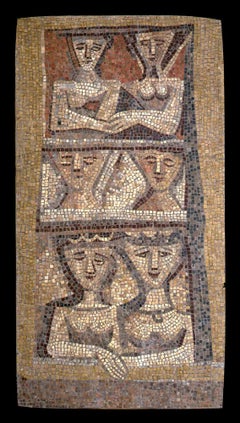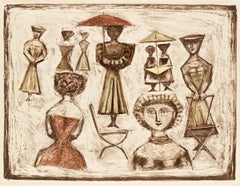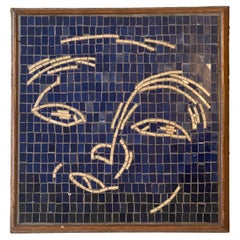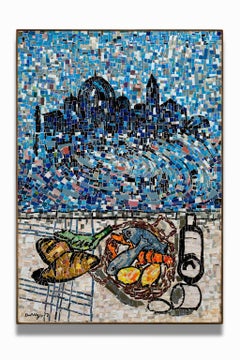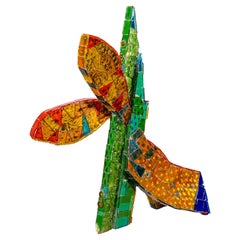Items Similar to Ombrellino (Umbrella) - Mosaic - 1947 ca.
Want more images or videos?
Request additional images or videos from the seller
1 of 3
Massimo Campigli, 1895-1971Ombrellino (Umbrella) - Mosaic - 1947 ca.1947 ca.
1947 ca.
$129,113.92
£94,099.52
€108,000
CA$177,034.56
A$197,663.73
CHF 103,106.76
MX$2,430,569.62
NOK 1,301,336.01
SEK 1,225,162.03
DKK 821,793.99
Shipping
Retrieving quote...The 1stDibs Promise:
Authenticity Guarantee,
Money-Back Guarantee,
24-Hour Cancellation
About the Item
Original Mosaic on cement panel.
Ref.: Domus 1948, p. IX and p. 29.
An awesome and beautiful example on Campigli's Art of creating imaginative characters following his creativity, successfully experimented in paintings, and one of the very rare mosaic he made during his life.
Unique piece, with certificate of authenticity on photograph by the artist's son Nicola Campigli on photo.
Massimo Campigli
(July 4, 1895 as "Max Ihlenfeld" - 1971)
was a Italian painter and journalist.
He was born in Berlin, but spent most of his childhood in Florence. His family moved to Milan 1909, and here he worked on the "Letteratura" magazine, frequenting avant-garde circles and making the acquaintance of Boccioni and Carrà. In 1914 the Futurist magazine “Lacerba” published his Giornale + Strada – Parole in libertà (Journal + Road – Free speech). During World War I Campigli was captured and deported to Hungary where he remained a prisoner of war from 1916-18. At the end of the war he moved to Paris where he worked as foreign correspondent for the Milanese daily newspaper "Corriere della Sera". Although he had already produced some drawings during the war, it was only after he arrived in Paris that he started to paint. At the Café du Dôme he consorted with artists including Giorgio de Chirico, Alberto Savinio, Gino Severini and Filippo De Pisis. Extended visits to the Louvre deepened Campigli's interest in ancient Egyptian art, which became a lasting source of his own painting.
His first figurative works applied geometrical designs to the human figure, reflecting the influence of Pablo Picasso and Fernand Léger as well as the Purism of "L’Esprit Nouveau".
In 1923, he organised his first personal exhibition at the Bragaglia Gallery in Rome. During the next five years his figures developed a monumental quality, often with stylised poses and the limbs interwoven into a sculptural solidity. The importance given to order and tradition, the atmosphere of serenity and eternity were in line with the post-war reconstruction and the programme of the “Twentieth Century” artists with whom Campigli frequently exhibited both in Milan from 1926-29 and abroad from 1927-31.
As from 1926, he joined the "Paris Italians" together with Giorgio de Chirico, Filippo de Pisis, Renato Paresce, Savinio, Severini and Mario Tozzi. In 1928, year of his debut at the Venice Biennial, he was very much taken by the Etruscan collection when visiting the National Etruscan Museum in Rome. He then broke away from the compact severity of his previous works in favour of a plane with subdued tones and schematic forms rich in archaisms.
During a journey in Romania with his first wife Magdalena Rădulescu, he started a new cycle of works portraying women employed in domestic tasks and agricultural labour. These figures were arranged in asymmetrical and hieratic compositions, hovering on a rough textured plane, inspired by ancient frescoes. These works were enthusiastically received by the critics at the exhibition held in the Jeanne Bucher gallery, Paris, in 1929 and at the Milione Gallery, Milan, in 1931. During the ‘thirties he held a series of solo exhibitions in New York, Paris and Milan which brought him international acclaim.
In 1933 Campigli returned to Milan where he worked on projects of vast dimensions. In the same year he signed Mario Sironi’s Mural Art Manifesto and painted a fresco of mothers, country-women, working women, for the V Milan Triennial which unfortunately was later destroyed. In the following ten years other works were commissioned: “I costruttori” (The builders) for the Geneva League of Nations in 1937; “Non uccidere” (Do not kill) for the Milan Courts of Justice in 1938, an enormous 300 square metre fresco for the entrance hall, designed by Gio Ponti, of the Liviano, Padua which he painted during 1939-40.
After divorcing in 1939, Campigli remarried with the sculptress Giuditta Scalini. Together they passed the war years in Milan and in Venice, then after the war they divided their time between Rome, Paris and Saint-Tropez. In 1943, his son Nicola was born in Venice.
In a personal exhibition at the Venice Biennial in 1948 he displayed his new compositions: female figures inserted in complicated architectonic structures. During the 60s his figures were reduced to coloured markings in a group of almost abstract canvasses. In 1967 a retrospective exhibition was dedicated to Campigli at the Palazzo Reale in Milan. He died in 1971 in Saint-Tropez.
- Creator:Massimo Campigli, 1895-1971 (1895-1971, Italian)
- Creation Year:1947 ca.
- Dimensions:Height: 45.28 in (115 cm)Width: 49.22 in (125 cm)Depth: 0.6 in (1.5 cm)
- Medium:
- Movement & Style:
- Period:
- Condition:Insurance may be requested by customers as additional service, contact us for more information.
- Gallery Location:Roma, IT
- Reference Number:Seller: J-773601stDibs: LU65036073782
About the Seller
4.9
Platinum Seller
Premium sellers with a 4.7+ rating and 24-hour response times
1stDibs seller since 2017
7,569 sales on 1stDibs
Typical response time: 2 hours
- ShippingRetrieving quote...Shipping from: Vizille, France
- Return Policy
Authenticity Guarantee
In the unlikely event there’s an issue with an item’s authenticity, contact us within 1 year for a full refund. DetailsMoney-Back Guarantee
If your item is not as described, is damaged in transit, or does not arrive, contact us within 7 days for a full refund. Details24-Hour Cancellation
You have a 24-hour grace period in which to reconsider your purchase, with no questions asked.Vetted Professional Sellers
Our world-class sellers must adhere to strict standards for service and quality, maintaining the integrity of our listings.Price-Match Guarantee
If you find that a seller listed the same item for a lower price elsewhere, we’ll match it.Trusted Global Delivery
Our best-in-class carrier network provides specialized shipping options worldwide, including custom delivery.More From This Seller
View AllWoman - Mosaic on Cement Panel by Massimo Campigli - 1940s
Located in Roma, IT
Mosaic on cement panel, realized by Massimo Campigli in the 1940s.
Certificate of authenticity on photograph by the artist's son Nicola Campigli.
Category
Mid-20th Century Modern More Art
Materials
Mosaic
$86,075 Sale Price
25% Off
Il balcone - Mosaic by Massimo Campigli - 1947
Located in Roma, IT
Mosaic on cement panel.
Bibliography: Domus 1948, p. 38; Wagner 2003, p. 88.
Exhibitions:
- "Massimo Campigli - Mediterraneità e Modernità", Darmstadt 2003, ed. Mazzotta, Klaus ...
Category
1940s Modern More Art
Materials
Mosaic
Lady - Original Mosaic - 1946/47
By Massimo Campigli, 1895-1971
Located in Roma, IT
An awesome and beautiful example on Campigli's Art of creating imaginative characters following his creativity, successfully experimented in paintings, and one of the very rare mosai...
Category
1940s Contemporary More Art
Materials
Mosaic
Price Upon Request
Women at the Window - Mosaic by Massimo Campigli - 1947
Located in Roma, IT
Mosaic on cement panel.
Exhibitions:
- "Massimo Campigli - Mediterraneità e Modernità", Darmstadt 2003, ed. Mazzotta, Klaus Wolbert, n. 218, p. 333 (full page).
- "Il Tempo dell...
Category
1940s Modern More Art
Materials
Mosaic
Bust of Woman with Pearl Necklace - Mosaic - 1947
By Massimo Campigli, 1895-1971
Located in Roma, IT
Mosaic on cement panel, realized by Massimo Campigli in 1947.
Unique piece, with certificate of authenticity on photograph by the artist's son Nicola Campigli on photo.
Bibliograph...
Category
1940s Contemporary More Art
Materials
Mosaic
$161,392
Free Shipping
Le Passeggiatrici - Lithograph by Massimo Campigli - 1957
Located in Roma, IT
Hand signed.
“Le Passeggiatrici” (“The Promenaders”) is a lithograph by Massimo Campigli, dated 1957. Two elegant female figures are the protagonists of this composition. The diffe...
Category
1950s Modern Portrait Prints
Materials
Lithograph
$2,600 Sale Price
25% Off
You May Also Like
Passeggiata Romana
By Massimo Campigli, 1895-1971
Located in New York, NY
A very good impression of this color lithograph. Artist's proof, aside from the edition of 175. Signed, dated and inscribed "Epreuve d'artiste" in pencil. Printed by Desjobert, Paris...
Category
1950s Futurist Abstract Prints
Materials
Color Pencil, Lithograph
MCM "Face" Mosaic on Board
Located in San Diego, CA
A real nice MCM "face"mosaic on board with dark blue background, circa 1970s. This well crafted piece is in good vintage condition and measures 13.75"W x 1.25"D x 14.25"H. Great colo...
Category
Mid-20th Century American Mid-Century Modern Wall-mounted Sculptures
Materials
Glass, Wood
$380 Sale Price
20% Off
Umberto Del Negro Mosaic Panel "St. Mark's Basilica From A Window"
Located in Detroit, MI
SALE ONE WEEK ONLY
"St. Mark's Basilica From A Window" is a playful and creative still-life mosaic depicting Venice's most famous cathedral church from the vantage point of a view perfect for someone to have their seafood lunch. The work is composed of over a thousand small mosaic pieces, giving the work an expressionist feel but also reminiscent of the works of Vincent Van Gogh. There is a dreamlike quality to this work that conjures collective memories of the sights and smells...
Category
1970s Still-life Paintings
Materials
Mosaic, Acrylic
Gerome Kamrowski Untitled (Mosaic Study) Signed Contemporary Mosaic on Wood
Located in Keego Harbor, MI
A contemporary mosaic on wood sculpture Untitled (Mosaic Study) by Gerome Kamrowski. Hand signed on sculpture. Circa 1980s. A surreal composition of an abstracted winged figure. Prov...
Category
Vintage 1980s American Abstract Sculptures
Materials
Art Glass, Wood
Marble and Glass Mosaic Panel, Meditation, Maximilien Herzele, France 1958
By Maximilien Herzele
Located in St Ouen, FR
This work was presented throughout 1962, successively at the Drian Galleries of London and then at the Musée des Arts Décoratifs in Paris, as part of solo exhibitions.
It illustrated...
Category
Mid-20th Century French Mid-Century Modern Wall-mounted Sculptures
Materials
Marble
David Holleman Mosaic Tile Art Panel with Sgraffito Illustratration
By David Holleman
Located in Chattanooga, TN
Mid-Century Modern era mosaic tile art panel by celebrated artist, David Holleman (1927-2020). Holleman is a prolific artist with a storied career spanning the better part of the 20th century and into the 21st. During his time serving with the US Army in Berlin, he became influenced by German Expressionist painter Carl Hofer. Once Holleman returned to the US he turned to ceramics as his primary medium. Despite winning national prizes for his pottery, he endeavored to further explore the medium. Holleman began working with his hallmark, mosaic tiles. Holleman produced over 50 mosaic tile murals...
Category
Mid-20th Century American Mid-Century Modern Decorative Art
Materials
Wood, Paint, Ceramic
More Ways To Browse
Picasso 1947
Vintage Italian Mosaics
Mosaic Panel
Campigli Massimo
Umbrella Abstract Painting
Saint Tropez Sign
Used Cafe Umbrellas
Vintage Dior Umbrella
Sironi Mario
Mario Tozzi
The Moon Photography
Abstract Belgian Sculpture
Horse Limited Prints
Saint Jacques
Suspended Sculptures
Vintage Photos Japan
Still Life Oil Painting Flower And Vase
Antique Fresco
